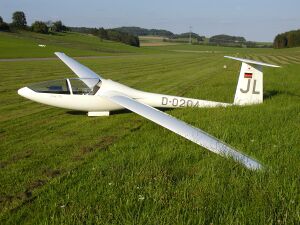Engineering:Glasflügel 401
From HandWiki
Short description: German single-seat glider, 1968
| 401 Kestrel | |
|---|---|

| |
| Glasflügel 401 Kestrel | |
| Role | Open class sailplane |
| National origin | Germany |
| Manufacturer | Glasflügel |
| Designer | Eugen Hänle |
| First flight | 9 August 1968 |
| Number built | 129 |
The Glasflügel 401 "Kestrel" is a glider that was developed in 1968 for the open class. It has a wingspan of 17 metres. It is named after the kestrel bird.
History
Between 1968 and 1975 Glasflügel built 129 Kestrels.
The British company Slingsby built the Kestrel under license as the T59 and T59B. The T59B has a wingspan of 19 metres and was developed for the 1970 World Gliding Championships.[1]
On 18 May 2005, Gordon Boettger flew 2061 km in his Kestrel in lee waves along the Sierra Nevada in the USA.[2]
Specifications
General characteristics
- Crew: One pilot
- Length: 6.72 m (22 ft 1 in)
- Wingspan: 17.00 m (55 ft 9 in)
- Wing area: 11.6 m2 (125 sq ft)
- Aspect ratio: 25
- Empty weight: 260 kg (570 lb)
- Gross weight: 400 kg (880 lb)
Performance
- Maximum speed: 250 km/h (160 mph, 140 kn)
- Maximum glide ratio: 43:1
See also
Related development
Aircraft of comparable role, configuration and era
Related lists
Notes
- ↑ Ellison, Norman (1971), British Gliders and Sailplanes, p.230. A & C Black, Limited, London. ISBN:0-7136-1189-8
- ↑ FAI 2000 km Flight Register Retrieved 2012-01-02
References
- Flight Manual
- Die Entwicklung der Kunststoffsegelflugzeuge, Dietmar Geistmann, Motorbuchverlag, ISBN:3-87943-483-2
- Sailplane Directory
 |

